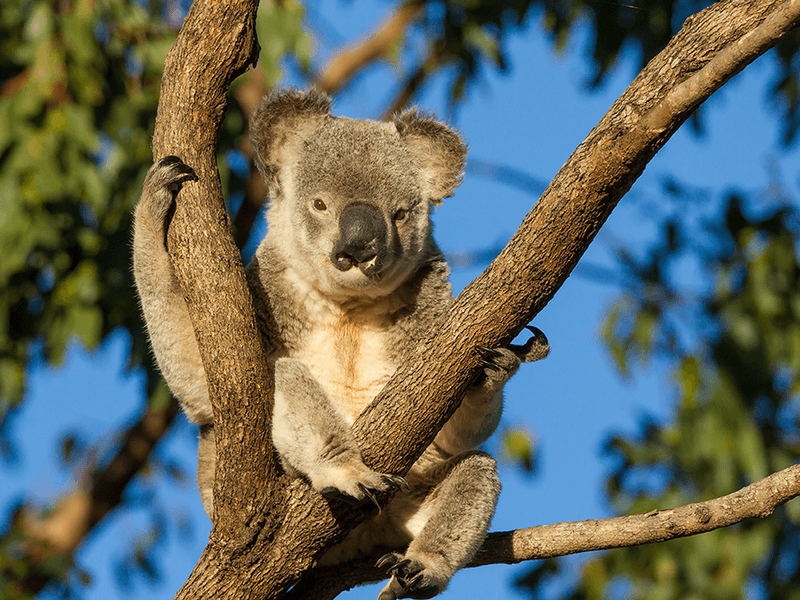Bezzants Lease | Bezzants Lease is a 2,535ha property located approximately 12km east of the township of Deepwater and almost on the crest of the Great Divide in Northern NSW. | | South Endeavour purchased the property in 2011 in order to ensure protection of its very high quality ecosystems which are almost totally intact. Bezzants Lease protects large areas of stunning old growth forest, with huge granite outcrops, extensive wetland systems, two endangered ecological communities and habitat of many threatened species. At least 470 native plant species are known to occur on the property. Bezzants Lease provides protection for many important natural heritage values, the most significant of which are outlined below: | 
| | | Koala, Bezzants Lease | Endangered Ecological Communities - Montane Peatlands and Swamps of the New England Tableland, NSW North Coast, Sydney Basin, South East Corner, South Eastern Highlands and the Australian Alps Bioregions, listed as endangered under the Threatened Species Conservation Act 1995 (NSW).
- New England Peppermint Woodland on Basalts and Sediments in the New England Tableland Bioregion, listed as endangered under the Threatened Species Conservation Act 1995 (NSW) and listed as critically endangered under the Environment Protection and Biodiversity Conservation Act 1999 (Cwth), named New England Peppermint (Eucalyptus nova-anglica) Grassy Woodlands.
Threatened species - Fauna: - Spotted-tailed Quoll Dasyurus maculatus (v, E)
- Koala Phascolarctos cinereus (v)
- Greater Broad-nosed Bat Scoteanax rueppellii (v)
- Little Bentwing-bat Miniopterus australis (v)
- Eastern Cave Bat Vespadelus troughtoni (v)
- Eastern Long-eared Bat Nyctophilus bifax (v)
| - Glossy Black-Cockatoo Calyptorhynchus lathami (v)
- Varied Sittella Daphoenositta chrysoptera (v)
- Barking Owl Ninox connivens (v)
- Powerful Owl Ninox strenua (v)
| The full biodiversity values of Bezzants Lease have not yet been well explored. Threatened fauna species that may occur in the conservation reserve, but which have not yet been identified, include: - Black-chinned Honeyeater Melithreptus gularis (v)
- Brown Treecreeper Climacteris picumnus victoriae (v)
- Diamond Firetail Stagonopleura guttata (v)
- Masked Owl Tyto novaehollandiae (v)
- Regent Honeyeater Anthochaera phrygia (ce, E)
- Speckled Warbler Pyrrholaemus sagittatus (v)
- Square-tailed Kite Lophoictinia isura (v)
- Swift Parrot Lathamus discolor (e, E)
- Turquoise Parrot Neophema pulchella (v)
- Brush-tailed Phascogale Phascogale tapoatafa (v)
- Eastern Bent-wing Bat Miniopterus schreibersii (v)
- Eastern False Pipistrelle Falsistrellus tasmaniensis (v)
| - Eastern Pygmy-possum Cercartetus nanus (v)
- Grey-headed Flying-fox Pteropus poliocephalus (v, V)
- Eastern Freetail-bat Mormopterus norfolkensis (v)
- Border Thick-tailed Gecko Underwoodisaurus sphyrurus (v, V)
- Pale-headed Snake Hoplocephalus bitorquatus (v)
- Booroolong Frog Litoria booroolongensis (e, E)
- Glandular Frog Litoria subglandulosa (v)
- Stuttering Frog Mixophyes balbus (e, V)
- Giant Dragonfly Petalura gigantea (e)
| Threatened flora species that may occur but have not yet been identified include: - Euphrasia ciliolata (Polblue eyebright)(v)
- Chiloglottis platyptera (Barrington Tops ant orchid) (v)
- Monotaxis macrophylla (Large-leafed Monotaxis) (e)
- Eucalyptus camphora subsp. relicta (Warra Broad-leaved Sally) (e)
| - Arthraxon hispidus (Hairy Jointgrass) (v, V)
- Boronia granitica (Granite Boronia) (v, E)
- Eucalyptus nicholii (Narrow-leaved Black Peppermint) (v, V)
| (v) = listed as Vulnerable, (e) = Endangered or (ce) Critically Endangered under the Threatened Species Conservation Act 1995. (V) = listed as Vulnerable or (E) = Endangered under the Environmental Protection and Biodiversity Conservation Act 1999. Rare or Threatened Australian Plants (ROTAPs – Briggs & Leigh 1996) that occur in the Conservation Area are as well as Threatened Flora (Threatened Species Conservation Act 1995): - Agiortia cicatricata (Rock Beard Heath)
- Brachyloma saxicola (Granite Daphne Heath)
- Callistemon pungens (Pungent Bottlebrush)
- Cryptandra lanosiflora (Woolly Cryptandra)
- Eucalyptus codonocarpa (Mallee)
| - Eucalyptus retinens (Hillgrove Box)
- Hibbertia villosa (Hairy Guinea Flower)
- Philotheca epilosa (Granite Philotheca)
- Muehlenbeckia costata (v) (Scrambling Lignum)
| Bezzants Lease is also part of a habitat stronghold of the small, isolated population of common wombats (Vombatus ursinus) on the New England Tablelands. While not formally recognised as an endangered population, the presence of this isolated population is significant, and the protection of Bezzants Lease makes an important contribution to ensuring the northern population can persist. Connectivity with existing conservation reserves The property is part of a vegetated area contiguous with Butterleaf National Park which borders to the south, Butterleaf State Conservation Area, and Butterleaf State Forest. The forest then connects through private lands to the large National Parks of the Great Dividing Range including Gibraltar Range and Washpool National Parks. There are significant areas of Wilderness nearby including the Washpool Wilderness Area 10 kms to the east, as well as Gondwana World Heritage Area 20 kms east of the reserve. The protection of Bezzants Lease (2535 ha) increases the protected area of Butterleaf National Park and State Conservation Area (which together total approximately 3715 ha) by approximately 68%. The Land lies within a climate change corridor (DECC 2007), contains part of a regional wildlife corridor and a large area of identified key habitat. |


